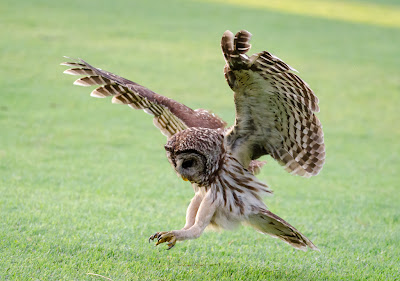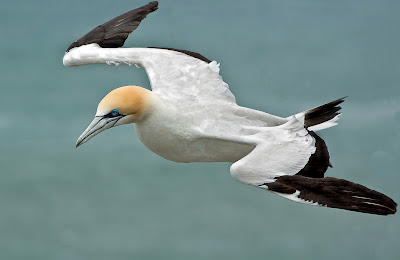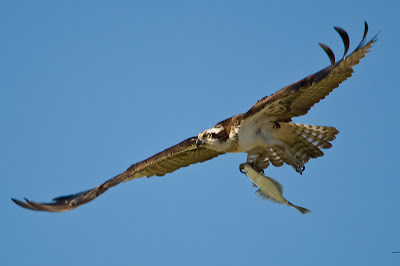Bird photography is one of the most challenging branches of Nature and Wildlife photography, and in it photographing birds in flight is undoubtedly the toughest trick to master. To get good photographs of birds in flight, one must possess great skill, a good deal of practice, and decent gear. It is one of those areas of photography where gear does matter.
 |
| Photo By Ken Douglas |
Here in this article we will discuss about tips that could help you master the art of photographing birds in flight. It will take a lot of practice and persistence to get there but as you slowly improve your skills you will notice that your keeper rate (ratio of good shots to bad ones) also improves.
1. Know you subject
As is the case with any other branch of nature and wildlife photography; good knowledge of the species of birds that you are about to photograph will go a long way in ensuring that you get good pictures of them. Each species of birds are different; they have their own feeding habits, flight patterns, breeding, nesting behaviour etc etc. having a good knowledge about the species will help you better adapt your technique to suit the characteristics of the birds and thus guarantee more success.
 |
| Photo By Camron Flanders |
It is good to know the direction of the wind, heavy birds often take off into the wind and the flight pattern and direction will change with changing wind direction. If you could find a nesting spot and position yourself unobtrusively you could notice that the parent birds follow the same route to get to the chicks, they’ll often reach the general area, land on some nearby tree or a high spot with good visibility of the nest and its surroundings, make sure there are no immediate threats (they do not want to attract attention to their nests) and once they are sure no adversaries are present they scoop down to the nest. This is a common strategy adopted by many smaller species. Wear dull colour dress preferably camouflage, and make sure your presence is in no way deterring the birds from visiting the nests.
2. Equipment matters
When it comes to photographing birds in flight, the gear you use could either make or break the shot irrespective of your skill level, it is kind of 50: 50 ratio thing. 50 % gear – 50 % skill. I know photographers who could take sharp photos of birds in flight with a digital camera mounted with a manual lens and no autofocus, that makes it a fully manual device – Manual aperture setting on the lens, shutter speed, ISO, manual focusing, no image stabilization, etc etc. Still they manage to get great shots, it’s nothing but the combination of great skill, much practice and to an extend sheer luck. But that is not a feast everyone could accomplish.
 |
| Photo By John and Fish |
Photographing birds in flight is a tough job and it is strictly DSLR territory. I do agree that you could take some great shots even with your point and shoot camera, but it is not worth the time and effort put in; as the only factor that could have made it possible is plain luck. The most important features to look for in your photographic gear is the speed of auto focus. It is mostly a combination of the speed of the lens auto focus system and the speed of the camera body used. Fast lenses with wider apertures let more light in to the sensor and thus are faster to achieve focus, so does lenses with Ultra Sonic Motors built in to the lens itself. Some camera bodies do have better auto focus performance than others. General rule is to stick with professional body and lens if you can afford it.
Second most important factor is the burst rate of your camera. The faster the better; latest generation DSLR’s are able to shoot 7, 8 frames per second which is great. You could also manage with a rate of 3 – 4 frames per second anything below it will make you miss certain shots.
3. Pick a Good Position
Find a suitable place, if possible a slightly elevated place like a hill so that you are somewhat level with the birds in flight and are not shooting pointed up. Also take note of where the sun is when choosing your position, it will be better if you have sun at your back as then the birds you are shooting will be front-lit; although birds in flight pictures which are backlit also do turn out pretty well, front-lit subjects are easier to expose right. Find a spot where the birds are flying parallel to your lens that is they are flying from side to side and not towards or away from you. Also pay attention to what constitutes your background, pick a spot from where you will have nice clean background that matches your subject.
 |
| Photo By Nathan Rupert |
4. Shooting Mode
You could choose either manual or any of the semi automatic shooting modes to shoots birds in flight. If you could adapt to changing light conditions and set exposure accordingly; then the best mode will be Manual; as it gets you consistent results. You could also use semi auto modes like the shutter priority and aperture priority modes. If you are an absolute beginner and do not wish to worry about exposure settings the best method is to set your camera to TV – Shutter priority mode, select a shutter speed of 1/1000 (should be enough for most situations) put your ISO settings to Auto and you are good to go. The camera will adjust Aperture and ISO combinations to get you the desired shutter speed.
 |
| Photo By Robin Ducker |
5. Burst mode / Continuous shooting mode
It is better to set your camera to the continuous shooting more or the burst mode so if you keep the shutter button pressed the camera takes many shots in quick succession. It will help increase your chances of getting the perfectly timed shot.
6. Focus Mode
Use the continuous auto focus mode in your camera; in case of Canon it will be AI Servo. If you know how to set the auto focus function to the rear button (independent of the shutter release) it would be of much help as you could have both the convenience of single shot focus and AI servo. We will be discussing how to set auto focus function to the rear button in a future article.
 |
| Photo By Bret Saalwaechter |
7. Selection of Focus Points
The selection of auto focus points depends on the actual scene; if you are shooting your birds against the clear blue sky or any other uncluttered background that is clearly far from the subject, then it is better to activate all the autofocus points your camera has. In other situations when there are other elements that could potentially distract the cameras focus pointers it is better to stick to the centre auto focus point only. In most cameras the centre auto focus point is the strongest and the fastest.
8. Focus delimiter
Many zoom lens have this function, it instructs the lens to limit itself to the set zoom range there by reducing the area the lens has to cover and thus making focusing easier. Set you focus delimiter to the telephoto range.
 |
| Photo By Bill Gracey |
9. Holding your camera properly
Knowing how to hold your camera properly is important. It is more so when using lenses of longer focal lengths. The best method is to hold the camera with your right hand, with your left hand supporting it at the far end of the lens (near the hood). Do not grip the camera very tightly, adopt a steady and easy stance with your legs slightly spread for more stability.
10. Master Proper Panning Technique
To get good pictures of birds in flight it is necessary to perfect your panning technique; stand relaxed in a position which allows you to shift fast. When panning, remember to rotate from your hip and not just your shoulder.
 |
| Photo By Bill Gracey |
11. File Format
Depending upon your shooting style choose either RAW or Jpeg format. RAW format gives you maximum flexibility while post processing and Jpeg will let you shoot the most number of frames before the camera’s buffer is filled. Personally I do not recommend shooting in RAW + Jpeg mode as it will slow down the actual shooting process and also fill your memory cards faster.
12. Use a Proper Lens Hood
A good lens hood helps you eliminate flare, especially if you are shooting into the light. It also helps improve picture quality by blocking stray light from entering the lens and also offers some protection to the lens.
 |
| Photo By Nick Chill |
13. Turn off Image Stabilization
Image stabilization is not such an important factor when shooting birds in flight as you are using very high shutter speeds. In normal cases Image Stabilization could work against you if you try to pan along with your subject. However some lenses have a panning mode (in case of Canon IS mode 2) which could detect motion in one direction and deactivate Image Stabilization in that direction. If your lens has such an option use it else it is better to turn Image stabilization off.
14. Lens Choice – Medium Tele photo
For shooting birds in flight the best lens options are fast lenses in the medium tele photo range of 200 – 500 mm. Prime lenses are better choices than zooms as any way you will be using the lens in its maximum tele photo length so zoom function is of little use. Moreover zoom lenses are typically slower and heavier than their fixed length counterparts. Weight should be a major factor influencing lens choice as you will be hand-holding for extended periods.
 |
| Photo By Victor Alvarez |
15. Shutter Speed minimum 1/500 ideally 1/1000 or higher
In order to freeze the movement of birds during flight a minimum shutter speed of 1/1000 is recommended. For slow moving species of birds you could even make do with 1/500. If for any situation you have to choose between Image Shake and Image Noise, compromise on noise.
16. Set ISO for the Required Shutter / Aperture Combination
If it comes to compromising any of the elements of exposure the first priority should be given to shutter speed, then the aperture and the last is ISO. There is no point in getting a perfectly noiseless image at ISO 100 if it has camera shake, or if only certain portions of the bird is in focus. Noise reduction software’s and improved high ISO performance of modern digital cameras could easily tackle noise issues.
17. Use Spot Metering
Using spot metering mode and taking metering from the body of the bird ensures that your bird is properly exposed even if the background or sky is not.
 |
| Photo By Gingiber |
18. Take a Break Every Few Shots
Every few shots, take a break to check your exposures and make corrections, check for focus, sharpness, background, depth of field, camera shake etc. It is a good idea to keep your camera aside, sit down or take a small walk and relax a while. It will help your body regain your energy and help muscles recoup; else fatigue will soon catch up and you will end up a very tired man with shaky hands making it either very difficult or impossible to shoot hand held.
19. Persistence is Key
Shooting birds in flight is not an easy skill to master. It requires a lot of patience and practice. Do not give up if initially you are not very successful. Keep your expectations really low, Persistence is the key here, keep on practising and soon you will get good results.
Post a Comment